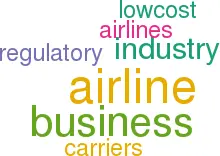Review: The airline business in the 21st century
January 2001


When Rigas Doganis published his standard textbook, "Flying off course; The Economics of International Airlines", in 1991, the European airline world as a very different place. Still extensively regulated, the state protection of flag–carriers was still largely accepted, the future for scheduled low–cost carriers seen as marginal at best, liberalisation was viewed as an inevitable but controllable regulatory change. In Doganis’s new book, published in November, he describes a radically changed aviation environment, one in which deregulation is the norm, markets are inherently unstable, and globalisation is the driving force for change.
"The airline business in the 21st century" is much more than a textbook, it is an important analysis of the key strategic issues facing the industry — the movement beyond open skies to true global markets through the erosion of nationality rules; the future of alliances; the low–cost revolution; the implications of e–commerce; and new airline business models.
Doganis succeeds in pulling together disparate underlying economic and regulatory trends to explain the recent evolution of the industry. There are also many pragmatic observations — to take one example, that managers at smaller carriers sometimes push their companies into alliances in order to be seen to be taking action, even if it is not necessarily the right action. This is a very balanced work. The merits are demerits of different airline models — virtual versus total aviation, for instance — are coolly appraised. Low–cost carriers are assessed individually rather than in generic terms. So when a bold assertion is made — that the airline business will consolidate into six to eight very large, albeit unstable, transnational airlines once ownership barriers are removed — it seems oddly out of place. A possible outcome, of course, but it has not just been regulatory opposition that has prevented the further, widely predicted, consolidation of the US industry.
Nor is it clear that drawing parallels between a service business like airlines and the oil industry is entirely justifiable.
Overall though, this is an essential read for those interested in the economic and strategic direction of the global airline business.
| Soviet pax. | Soviet freighter | Western | Total | |
| Aeroflot | 64 | 11 | 28 | 103 |
| Pulkovo | 44 | 0 | 0 | 44 |
| Vnukovo | 45 | 3 | 0 | 48 |
| KrasAir | 39 | 14 | 0 | 53 |
| Sibir | 32 | 0 | 0 | 32 |
| Transaero | 1 | 0 | 8 | 9 |
| Domodedovo | 18 | 4 | 0 | 22 |
| Kolavia | 11 | 0 | 0 | 11 |
| TyumenAT | 37 | 2 | 0 | 39 |
| Volga Dnepr | 4 | 2 | 0 | 6 |
| Aerosvit | 0 | 0 | 4 | 4 |
| UIA | 0 | 0 | 5 | 5 |